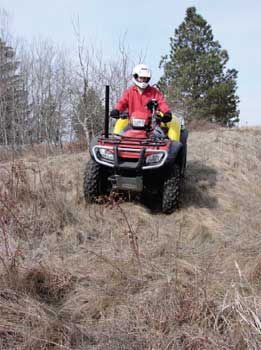Application and Equipment Issues
Existing ATV sprayers apply herbicides using a small diaphragm pump that produces a constant pressure, typically 20 to 40 pounds per square inch. For herbicides to be applied at a constant rate (typically given in gallons per acre), the applicator must operate the ATV or UTV at a set speed. Ditches, rocks, loose soil, holes, brush, trees, and steep slopes make it impossible to safely maintain a set speed (figure 2). If an ATV slows to half the intended speed, the amount of herbicide applied can double. It's not economical or desirable—and may be illegal—to apply twice the intended rate of herbicide.
Constant-rate sprayers, such as the one being tested by MTDC, automatically vary the pressure to the spray nozzle. As the vehicle goes faster, the pressure and flow to the nozzle increase. As the vehicle slows down, the pressure and flow decrease. A computerized controller, flowmeter, and GPS speed sensor work together to vary the system's pressure by adjusting the speed of the pump.
Constant-rate sprayer systems have drawbacks. Computerized controllers add complexity, require more time to calibrate, and are one more piece of equipment that can go wrong. Changing the system pressure alters spray patterns, drift, and droplet size. Improvements in GPS tracking, diaphragm pumps, controllers, and nozzles are reducing or eliminating some of the problems associated with constant-rate spray systems.

Figure 2—Slowing an ATV on steep slopes,
around ditches, rocks, or brush will cause spray
application rates to increase with a standard
sprayer. A constant-rate sprayer automatically
varies the pressure to the nozzle when the ATV
changes speeds.
Test equipment for the 12-volt constant-rate sprayer was set up on a Honda Foreman ATV. The system includes a spray tank, control system with console, GPS speed sensor, flowmeter, pump, electronic pump driver, and nozzle. Except for the spray tank, this system could easily be adapted to a UTV. The test included spraying with boom and boomless nozzles to see how well each type of nozzle functioned with the constant-rate sprayer.

